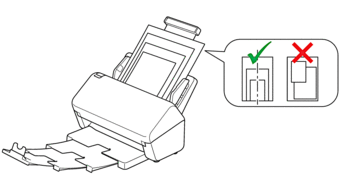Home > Paper Handling > Document Specifications > Unacceptable Documents > Scan a Mixed Batch
Scan a Mixed Batch
The following conditions apply when scanning a mixed batch of documents with different paper weights, friction coefficients, or sizes. Make sure to test a few sheets first to check if the documents can be scanned.
- Paper direction
- Align the direction of the paper fiber with the feed direction.
- Paper weight
- Use the following paper weights:
11 lb to 53 lb (40 g/㎡ to 200 g/㎡)
- Friction coefficient
-
We recommend using the same type of paper from the same manufacturer. When papers of different manufacturers/brands are mixed, it affects the feeding performance as the difference in the friction coefficient increases.
We recommend using friction coefficients between 0.35 and 0.6 (reference value for paper friction coefficient).
- Document position
- Use paper sizes that fit the 1.77 in. (45 mm) width of the Pick Up Roller in the center.
- Paper size
-
When you scan a mixed batch with different sizes, not feeding the documents straight may cause problems, such as paper jams or part of the image to appear missing.
We recommend checking the documents thoroughly before scanning and also checking the image if the document was skewed.
 When scanning a mixed batch with different sizes, documents are more likely to skew while feeding because the Paper Guides do not touch every sheet.
When scanning a mixed batch with different sizes, documents are more likely to skew while feeding because the Paper Guides do not touch every sheet.
- Documents that cannot be scanned in a mixed batch
- The following types of documents cannot be mixed in the same batch:
- Carbonless paper
- Bond paper
- Perforated documents
- Thermal paper
- Carbon-backed paper
- OHP film
- Tracing paper
- Synthetic paper
- Bent or damaged documents
- Thin paper
Less than 40 g/㎡
- How to scan a mixed batch
-
Load your document in the ADF in descending order of paper size with the largest at the back and the smallest at the front.
 If you are loading a paper business card, load it horizontally.
If you are loading a paper business card, load it horizontally.



